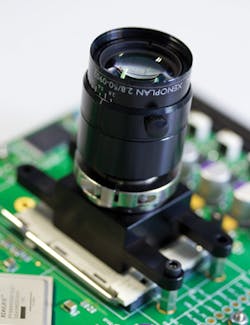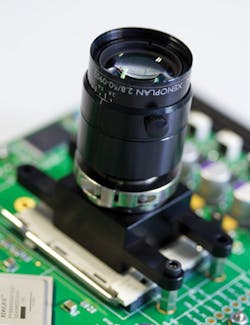BIOIMAGING/SPECTROSCOPY/LIGHT SOURCES: BiOS exhibits showcase tools for future biomedical advances
The exhibits at this year's Biomedical Optics Symposium (BiOS), which was once again the major component of the annual mega photonics event Photonics West (San Francisco, CA; January 21–27), featured exciting advances in a wide range of biophotonics tools: Spectral imaging systems, spectroscopy tools, cameras, and light sources, among other areas. The tools on display target a broad selection of life sciences uses, including optical coherence tomography (OCT), two-photon microscopy and other types of scientific imaging, quantitative analysis, and many more biomedical applications.
Multispectral and hyperspectral imaging
Spectral imaging combines spectroscopy and imaging, and allows discrimination among objects that are not distinguishable using standard imaging methods. It is a methodology that includes both multispectral (which produces a number of images at discrete, narrow wavelength bands that may range from the visible to the infrared) and hyperspectral (which produces the spectra of all pixels in a view by imaging narrow bands over a continuous range) imaging. Traditional spectral cameras are large, expensive, and slow—and thus their application has been limited. But new developments are chipping away at the old guard on multiple fronts, aiming to make spectral imaging tools available to those doing time-critical and high-throughput applications on limited budgets and with limited space.
One of the first things I got to see when the doors opened at BiOS 2012 was the compact, relatively low-cost ($20,000) SpectroCam multispectral imaging (MSI) development platform from Ocean Thin Films (Largo, FL). This "first fully configurable MSI camera" combines a scientific-grade CCD array with a customizable rotating optical filter wheel for simple generation of eight views of specimens. "As you change wavelengths, you generate different 'spectral slices,' and different things pop out," said Ocean Optics' CTO Jason Eichenholz, as he demonstrated how scientists at Halifax University (Canada) are using the system in cancer research. The system targets the many applications for which standard hyperspectral imaging systems are overkill—and it works faster as well.
Another effort to lower the cost and enhance the speed of spectral imaging was evident at the Imec (Leuven, Belgium) display, where scientists made the first public display of a chip-based hyperspectral imaging sensor. The fully integrated, CMOS-compatible sensor consists of a set of spectral filters that are directly post-processed at wafer level on top of a commercially available CMOSIS CMV4000 image sensor (a 4 Mpixel sensor with a maximum frame rate of 180 fps). Imec says its tunable filter offers up to 100 spectral bands between 560 and 1000 nm, with bandwidth ranging from 3 nm at 560 nm to 20 nm at 1000 nm, and transmission efficiency of approximately 85%. According to Imec, typical integration times used in its prototype setup are between 2 and 10 ms under halogen light illumination of 450 W, which translates to frame rates up to 500. Scanning speeds up to 2,000 lines/s significantly exceed current state-of-the-art hyperspectral sensors.
More and better spectroscopy
A UK-based company, ZiNIR, unveiled Solo Spectroscopy, a robust, "next-generation spectrometer" that claims to have pioneered the combination of dispersion and detection functions on a single chip. According to ZiNIR, the structure reduces the possibility of stray light, since photons do not need to travel between a grating or mirror and the detector. With no moving parts (mechanical or electrical) and the ability to operate in extreme conditions, Solo promises to enable the application of spectroscopy in areas it has not previously been considered.
SiWare Systems (Cairo, Egypt) introduced another highly compact monolithic spectrometer: A microelectromechanical systems (MEMS)-based Fourier transform infrared (FTIR) unit that promises high vibration tolerance and easy integration into a wide range of devices.
B&W Tek (Newark, DE) introduced its Glacier X miniature fiber-coupled spectrometer for fluorescence and Raman spectroscopy applications, calling it "the smallest TE-cooled spectrometer on the market."
A couple of Canadian developers also displayed interesting spectroscopy tools: P&P Optica (Waterloo, ON) announced an "advanced spectroscopic data analysis and acquisition software suite" called Iris, which aims to improve the usability of spectroscopic instrumentation (regardless of manufacturer) through automated calibration, aberration detection, and other features. And FiberTech Optica (Kitchener, ON) introduced compact, rugged fiber-optic Raman probes optically configured to enhance throughput and signal quality.
Impressive imaging
Sensors Unlimited – Goodrich ISR Systems (Princeton, NJ) introduced a high-resolution, 1.3 Mpixel shortwave infrared (SWIR) camera that the company says will "revolutionize" the SWIR imaging market. And partner company BaySpec (San Jose, CA) promoted its complete line of 50 custom spectral engines for optical coherence tomography (OCT), and the fact that, since the company makes its own gratings, it can center the wavelength range anywhere between 50 and 400 nm.
Edmund Optics' (Barrington, NJ) booth hosted a demonstration of UVP's (Upland, CA) iBox Explorer, which enables in-vivo visualization of both macro and micro levels-from whole organs to individual cells. Designed with a high numerical aperture and long working distance, the system accommodates live mice, and has proven important in research on cancer metastasis.
D3 Engineering (Victor, NY), a Texas Instruments Platinum Developer, announced the results of a partnership with New Scale Technologies and Sunex: A new OEM SmartCamera Developer's kit that targets compact instrumentation for medical and biometric applications. The kit integrates TI's DaVinci DSP with New Scale's M3-F autofocus module for "the highest precision lens motion available in [a ~1 in cube]." Kits can be customized with a variety of lenses and image sensors for resolution up to 14 Mpixels.
Phasics (Palaiseau, France) introduced "the first compact phase imager with unequalled sensitivity" that is dedicated to biology applications. The SIDbio wavefront sensor, based on patented 4-wave lateral shearing interferometry technology, simultaneously measures local phase shift and intensity within a specimen.
Hamamatsu Corp. (Bridgewater, NJ) and Photonis USA (Sturbridge, MA) featured camera developments that portend such great capability for life scientists: Hamamatsu's "game changing" ORCA-Flash4.0 with remarkable quantum efficiency, low noise, and signal-to-noise ratio addresses a wide range of bioimaging needs, while Photonis's xSCELL high-speed (1000 fps at 1024 × 1024 resolution) boasts read noise of less than 2 e- rms.
And new Photonics West exhibitor, GreatEyes (Berlin, Germany), promoted its "compact, cost-effective, and high-performance" CCD camera architectures for imaging and spectroscopy.
The right light
Heliophor, 89 North's (Burlington, VT) pumped-phosphor light engine for quantitative fluorescence microscopy, won the Photonics West Prism award in the category of Life Sciences and Biophotonics this year. The judges cited Heliophor's stability and straightforward calibration capability, which they said ensures consistent output intensity across measurements, allowing repeatable, truly quantitative fluorescent analysis.
Another interesting light source on display, Lumencor's (Beaverton, OR) solid-state excitation subsystem, SOLA, is "a true arc lamp replacement" that produces continuous white light from 380 to 680 nm in order to optimize the most common fluorophores and fluorescent proteins.
Other exciting news in light sources came from Newport (Irvine, CA): Its new Wavelength Extension Unit (WEU) is a pre-aligned turnkey solution that can be easily integrated with ultrafast light sources to enable multimodal spectroscopy and imaging, and can turn a standard two-photon microscope into a multimodal unit by adding other modalities, such as second harmonic generation (SHG) or coherent anti-stokes Raman scattering (CARS).
Coherent (Santa Clara, CA) launched the first orange optically pumped semiconductor lasers (OPSLs), an expansion of its Sapphire line, which target a number of fluorescent dyes used in bioimaging. Coherent has also added to its Genesis family of lasers: The new CX 355 STM Compact is a continuous-wave, 355 nm unit designed for space-conscious OEM applications.
A new company, Accendo Systems (Champaign, IL), boasted the smallest footprint in the world for a femtosecond Ti:sapphire laser, and the only such system without a chiller. Its Volcan air-cooled, passively mode-locked system is smaller than a shoebox and requires no vibration-isolation optical table (it can be operated even on a moveable cart). The Volcan 2 Series is pumped by a 5 W diode-pumped, solid-state laser, which can deliver enough power for even fiber-based imaging systems. Its high output power and broad spectral bandwidth (>60 nm) make it suitable for broadband OCT; other biomedical applications include multiphoton laser scanning and fluorescence microscopy, pump-probe experiments, and nonlinear spectroscopy.
For sure, there was more worthy of coverage happening at BiOS/Photonics West than we have time or space to cover in this report; stay tuned to our blogs and articles on www.bioopticsworld.com as we continue to hit highlights of the event. The next Photonics West will take place February 2–7, 2013: spie.org/x23685.xml.
More BioOptics World Current Issue Articles
More BioOptics World Archives Issue Articles


